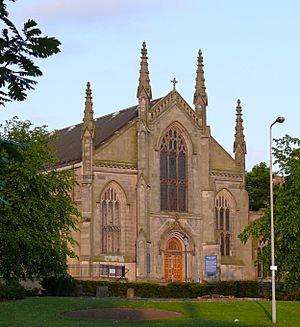St Mary's Cathedral, Edinburgh (Catholic) facts for kids
Quick facts for kids St Mary's Metropolitan Cathedral |
|
|---|---|
| Metropolitan Cathedral of Our Lady of the Assumption | |
 |
|
| Lua error in Module:Location_map at line 420: attempt to index field 'wikibase' (a nil value). | |
| Location | Edinburgh |
| Country | Scotland |
| Denomination | Roman Catholic |
| History | |
| Former name(s) | Chapel of St Mary's (1814) |
| Status | Metropolitan Cathedral (of the Province of St Andrews and Edinburgh) |
| Dedication | Our Lady of the Assumption |
| Consecrated | 1814 |
| Architecture | |
| Heritage designation | Listed B |
| Architect(s) | James Gillespie Graham |
| Style | Neo-Gothic |
| Completed | 1814 |
| Administration | |
| Archdiocese | St Andrews and Edinburgh |
| Province | St Andrews and Edinburgh |
St Mary's Metropolitan Cathedral is an important Roman Catholic church in Edinburgh, Scotland. It is also known as the Metropolitan Cathedral of Our Lady of the Assumption. This church is the main seat for the Archbishop of Saint Andrews and Edinburgh. It is considered the most important church for Catholics in Scotland. You can find the cathedral in the city centre, at the East End of New Town.
Contents
History of St Mary's Cathedral
The Chapel of St Mary's first opened its doors in 1814. It was designed by James Gillespie Graham. This new church replaced an older one called the Chapel of St Andrew the Apostle. The older chapel was on Blackfriars Wynd. Building a new, special church showed that the Catholic faith was widely accepted by 1814 in Scotland.
Growth and Changes Over Time
Over the years, the church was made much grander. In 1878, when the Catholic Church in Scotland was reorganised, it became the main church for the new Archdiocese of St Andrews and Edinburgh. On July 5, 1886, it was officially renamed the Metropolitan Cathedral. This new name gave it special rights and importance. The cathedral also holds the National Shrine of Saint Andrew.
Papal Visit to the Cathedral
A very special event happened in May 1982. Pope John Paul II visited St Mary's Cathedral. This visit was part of his trip to Scotland.
Architecture and Design
The building was designed between 1813 and 1814. Its style is called neo-perpendicular. This means it looks like older Gothic churches. The main architect was James Gillespie Graham. Later, Augustus Pugin added more designs.
Changes After a Fire
In 1892, a fire at the nearby Theatre Royal caused some damage. This meant the cathedral needed changes. New arches were made in the side walls. Aisles were added on both sides. These new parts were designed by John Biggar. The sanctuary, which is the area around the altar, was also made longer.
Later Additions and Renovations
In 1921, a war memorial and a new main altar were added. These were designed by Reginald Fairlie. A special canopy over the altar, called a baldachino, was put in place in 1927. In 1932, the roof was made taller by architects Reid and Forbes.
In the 1970s, old buildings next to the cathedral were taken down. This opened up the front of the church. The old porch and baptistery were replaced with a larger porch. This was designed by T. Harley Haddow. The sanctuary was also updated to fit new church rules from the Second Vatican Council.
Music at St Mary's
The cathedral has a special group of eight singers called the Schola Cantorum. They sing many types of sacred music. This includes plainchant, older polyphony music, and newer songs. There is also a mixed-ability cathedral choir.
The Cathedral Organ
A new organ was put into the cathedral in 2008. It was built by Matthew Copley. This amazing instrument has 4,000 pipes!
Music Director and Concerts
The Director of Music is Michael Ferguson. He also teaches at the University of St Andrews and writes music. From 2009 to 2016, the cathedral hosted concerts and recitals. These events were part of the Edinburgh Festival Fringe.
Current Clergy
The clergy are the religious leaders who work at the cathedral.
- Fr Jeremy Milne, VG (administrator)
- Fr Robert Taylor
- Fr Tadeusz Puton SAC (non-resident), who is the Chaplain of the Polish Mission.
Parish Organisation
Since 2017, the many Catholic parishes in Edinburgh have been grouped together. This helps them share resources better. St Mary's Cathedral is part of Cluster 1. The other churches in this group are St Ninian and Triduana, St Patrick, and St Albert.
Cafe Camino
The cathedral used to have a café in a building next door. This café was called Cafe Camino. It was also used as a place for performances during the Free Fringe at the Edinburgh Festival Fringe.
Administrators of the Cathedral
The administrator is the person in charge of running the cathedral. Here is a list of some of the people who have held this important role:
- Mgr. William Smith (1878–1885)
- Canon James Donlevy (1885–1903)
- Mgr. Alexander Stuart (1903–1923)
- Canon Patrick McGettigan (1923–1947)
- Mgr. John Breen (1947–1956)
- Mgr. Patrick Quille (1956–1982)
- Mgr. Patrick J. Grady (1982–?)
- Mgr. David Gemmell (?–2008)
- Mgr. Michael B. Regan (?–2015)
- Mgr. Patrick Burke (2015–2024)
- Mgr. Jeremy Milne (2024–present)
See also
 In Spanish: Catedral de Santa María de la Asunción (Edimburgo) para niños
In Spanish: Catedral de Santa María de la Asunción (Edimburgo) para niños


